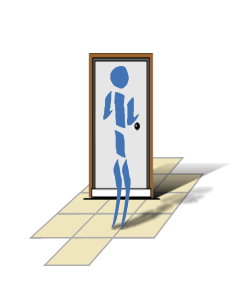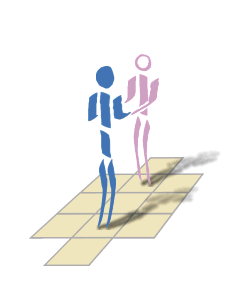Fundamental to modern jive is the "feel" which is enjoyable, essential for leading and synchronises the partnership's timing. This feel does not come from the position of the feet and a frame as in many other dances but an alternating and matching force between the hands of the leader and the follower. This force changes from "tension" as the couple are tugging away from one another to "compression", when they are pushing away from each other. This exercise is in 7 parts and helps you both experience this jive feel as a beginner. It is also a good exercise for improvers as it helps you understand how much freedom you really do have to change your style depending on the mood of the music, crowd conditions or the lady you are with.
Stand with your feet together about 0.5m (18 inches) from a closed door or
wall. Keep your feet in place at all times. Keep your body straight
but start to fall towards the door and as you do so, place your hands out in
front of you to slow yourself down. Ensure that you do not let your hands
fully collapse and get a nose bleed! As your nose approaches the door you
should increase the force to
 slow yourself down to stationary. Continue to
push so that you move back to an upright position again. You can allow
your hands to have contact with the door the whole time or just as you are
falling and rising back. Allow yourself to fall again. Repeat this
to learn that it is force in your hands that changes your movement to the
opposite direction.
slow yourself down to stationary. Continue to
push so that you move back to an upright position again. You can allow
your hands to have contact with the door the whole time or just as you are
falling and rising back. Allow yourself to fall again. Repeat this
to learn that it is force in your hands that changes your movement to the
opposite direction.
Now find a convenient door knob (closed door!) and try leaning backwards and as you do so reach out and grab the handle and slow yourself down to stationary. Ensure that you do not allow your arms to fully straighten. Continue to pull so that you become upright again. You should feel the force build up and die down as you fall and come back upright.
Now put the two exercises together allowing yourself to fall towards the door, breaking your fall and then push back so you become upright and then fall backwards and use your hand on the door knob to slow yourself down and then pull yourself back. You can tie a piece of string to the door knob and grab it as door knobs are often too low. Indeed when this is done one can even practice turning and stepping back etc! The important learning point is that one can do this VERY SMOOTHLY and get a good feeling of how the hands should be when jiving.
The purpose is to ensure that you get the correct compression and tension as you move your feet.
Both stand facing one another slightly further back than usual for jive, feet together,
double
 hand hold.
hand hold.
Continue this motion, taking about 2 seconds for each repetition, keeping your right foot in place, and just move your left forwards and backwards placing weight on it in these positions, allowing weight on your right foot momentarily between these. The feet pattern described in this exercise is actually unimportant, it is just the simplest pattern to ensure your bodies actually travel together and away. What is important is the distance the bodies move and the pressure between the hands.
If a partner is not available, try grabbing hold of any firm object such as a doorknob or door surround etc. Since the follower only mirrors you, the effect will be identical.
As you are doing this exercise, take care with the following:
It can be helpful for the lady to imagine that she is strapped with a bomb on her back and a sensor measuring how centrally placed her hands are between your two bodies. If they move too much nearer to her or too far away, or her arms go straight, it will explode. Additionally, there is a "jerk sensor" which will trigger the bomb if she jerks too much.
This exercise is to show that you can increase the distance travelled and get a naturally increasing force on the arms.
Start the basic exercise to music for a few beats then increase the distance travelled. The effect should be that you have to travel faster (to keep the same beat), so need more force to turn you around when you are apart and together.
Now reduce the distance travelled. Notice the reduced force.
Now alternate between a few beats with a large distance travelled and a few beats with less. Ensure that the follower mirrors with distance and force and changes in response to the leader.
His exercise is to show you that you can be smooth in the use of force or have a degree of "attack".
Repeat the basic exercise to music, keeping the distance travelled the same, but be much sharper with greater force. Notice that you take less time to change direction.
Now use much less force more smoothly. Notice that your force builds up slowly and decreases slowly. The force should build up and die down like a wave.
Alternate between abrupt and smooth a few times.
This exercise is to show you that you can use your body to alter the natural force needed to change your direction.
Repeat the basic exercise, keeping the distance travelled the same and the attack the same, but increase the tension there is between your arms when outstretched and compression when together. You will notice that your posture changes and you feel yourself leaning into her or braking.
Now decrease the tension, so low that it is only a nuance!
Alternate from lots of force to little a few times. You will notice that this is hard work - it is not recommended as a natural movement!
This exercise is to show you that you can use also your body to alter the natural force needed to change your direction.
Repeat the basic exercise, keeping the same force and attack, but make your distance travelled large. Notice that your posture changes and you feel yourself leaning into her or braking.
Now decrease the distance so you are hardly moving. This will also feel like hard work.
Now try some beginner moves such as the octopus or catapult, convincing yourself that you can do it i) forcefully or really lightly as if the lady had brittle bones ii) to expand to fill the floor or in a confined space iii) in a staccato manner to suit boppy music or really smoothly. Ask the lady (or man, depending on who is altering the style) which she/he prefers.
You should now be realising that you have three degrees of freedom, pressure, distance and attack. You should now experiment how you wish to jive to different types of music, dance floor conditions and different sizes and weight of ladies etc. Don't be limited - change your style to suit the occasion. As a leader, try changing your style to match the next following you get. Hopefully as a result, "Mr ham-fisted" and "Miss limp lettuce leaf" will have experienced each others tendencies!
You are either reading this because you are curious or just cannot believe that anyone could be so nerdy as to provide the following explanation on a site for dancing! Here goes...
The motion above could be simply modelled with a spring (spring constant k, ie force required for a unit extension) connecting two masses (mass m). However this would produce a sinusoidal waveform. You will notice that the movement is i) often just a pulse of momentum change for a fraction of a second ii) non-linear as your bodies can "lean into" each other and iii) you can alter the "spring constant" of your arms at will!
Indeed the more astute amongst you will realise, after equating F=ma=md2x/dt2 to F=kx, then solving the differential equation and substituting a sinusoidal general equation that the frequency of oscillation is sqrt(k/m)/(2pi). This is left as an exercise for the reader - but best not done while dancing! Since m is constant and so is the frequency, then the elasticity of your arms are fixed - which is nonsense! Clearly there is more freedom than this simple equation suggests. We therefore consider a different model.
Observation suggests that the travel velocity is roughly constant until it changes direction at the end of travel and it then does this with more or less of a jerk. Consider the basic exercise above. In order for the man to travel distance x in t seconds (the beat duration), his velocity must be roughly v=x/t. His momentum is therefore p=mv. In order to change direction from v to -v ie 2x, the momentum change is 2mv. Now since force F is rate of change of momentum or dp/dt (for simple cases), then as you travel a greater distance, with a greater velocity and greater momentum in the same time, then the force must be greater. This explains 1c.
For 1d (changing the attack), dp stays the same and so dp=F.dt. One can simply increase the force with a corresponding reduction in the time period over which it applies, thus maintaining dp.
So far, the above exercises could be conducted on roller-skates. Exercises 1e and 1f introduce a new concept that extra force can be applied. Consider that when the couple are under compression close together that they lean into each other. Their bodies acts like a beam and their weight combined with the friction of their feet adds extra horizontal pressure. This perhaps makes hard work of dancing!
Was there any point in describing all that? Probably not, but it was fun thinking it through!